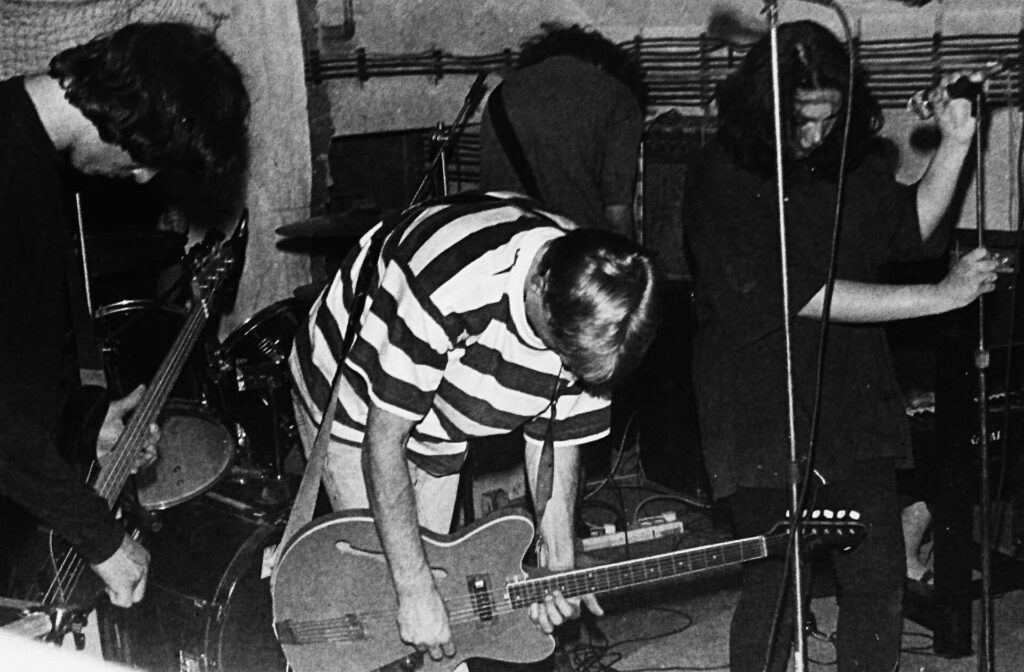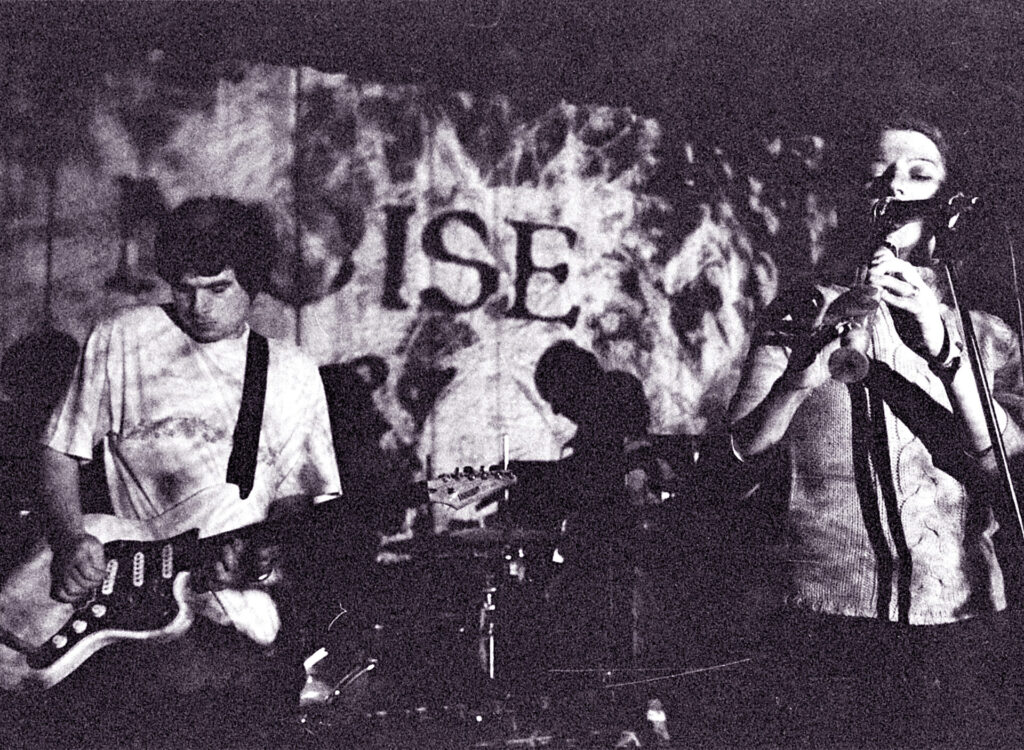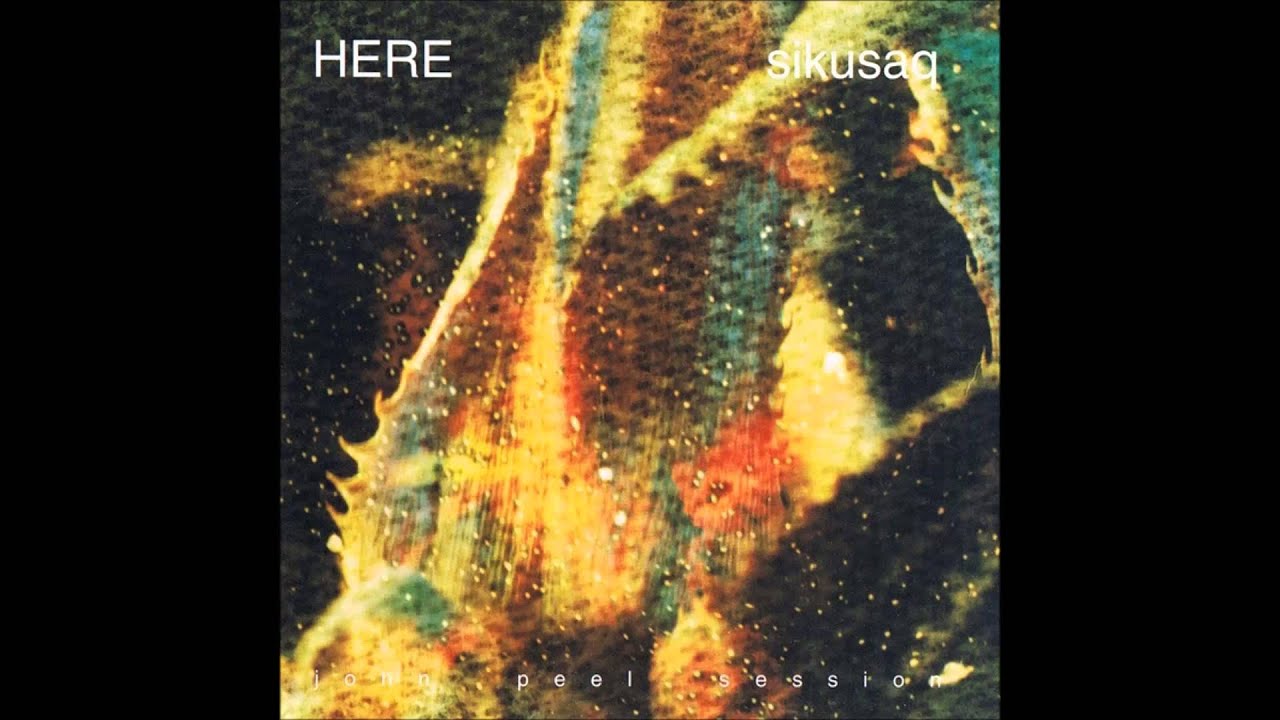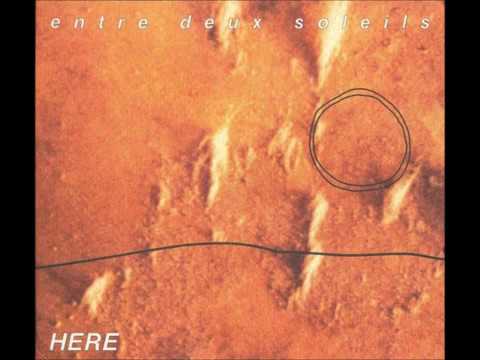The idea to start the band Here initiated with cousins Zdeněk Marek and Tomáš Luska. It happened in Vyškov na Moravě, a small town of 20,000 about a two-and-half hour drive south-east from Prague, ringed round by concrete Socialist housing estates and known as the seat of a military academy and army barracks. During communism, Vyškov was a tough, despotic town for young people. This is why Luska describes the arrival of a cassette tape from a friend in 1990 – right after the 1989 Velvet Revolution – as a kind of epiphany. One of the cousins had met a French girl, Valerie Chauvey, when studying in socialist Bulgaria, and she supplied them with the new music she had taped from a France Inter radio broadcast of Bernard Lenoir’s show L’Inrockuptible. Lenoir, “the French John Peel”, was introducing groups from across the Channel and that’s where Luska heard Nowhere by Ride for the first time, on Valerie’s cassette: “I listened to it at home in bed when my parents were watching TV in the living room. I couldn’t sleep that night – maybe two nights. It was savage. I had headphones on, I was lying down, staring up at the ceiling, and nobody around me had the faintest idea what was going on inside my head.”
This is the ineffable feeling Ride could evoke on stage as well. A live music reviewer in the LA Times stated in April 1991 that Ride “looked like young teen-agers stumbling onto something almost beyond their comprehension”. So too with Luska, a land-locked Czech, for he was encountering those oceanic feelings for the very first time, ones he could barely describe. “Sometimes something hits you, and you don’t know exactly what it is.” He played guitar, Marek bass, the cousins brought friends from their local pub into the band: they added Martin Pecka on drums, Pavel Koutný as a second bassist and their first female vocalist Kateřina Crhonková, a goth who worked at the local nursery school. Here were wild childs – Luska, Marek and Pecka looked like hippies, but were into hulking guitar feedback, and noise, so they invented a genre for themselves: flower noise. They never belonged anywhere, and that was a big part of their appeal.
In the capital city of Prague, shoegaze and indie were already a scene, with bands like Ecstasy of St. Theresa, Toyen, and Naked Souls – Here were fellow travellers from Moravia, from the eastern part of the country. Their debut album Swirl was recorded in 1993 in a studio nestled amidst gardening sheds and summer cottages near Brno, where they would spend their free time taking walks in the meadows, strolling by a fox breeder’s and corralled horses. They were composing directly in the studio and enjoyed that more than live gigs. What fascinated them about shoegaze were the dreamlike soundscapes and sonic spaciousness: “As opposed to other music, which sketches sound in distinct contours, noise spreads and multiplies… Noise and shoegaze are for people with imagination,” says drummer Martin Pecka.
Journalists wondered why such an ethereal group bore such a mundane name: “Our lyrics express feelings, reflections, moments. No politics. Here, the present,” they said in an interview for UNI magazine, which called them one “of the most interesting phenomena on our indie scene”. As opposed to most of the music of the time, Swirl has not aged much, as if created somewhere outside time, in that strange period after the Velvet Revolution, when everything was in flux. You can hear the influence of Ecstasy of St. Theresa, and in places a cloudlike sound reminiscent of their Susurrate album. The same as for associated Prague groups, producer and engineer Colin Stuart, hailing from Britain, was at the controls, but Swirl is more song-like, and each track has a strong melody lurching underneath swathes of guitar noise.
The intro to ‘Flower Rain’ starts out like a Cranberries-type guitar ballad, and the following ‘Haze’ has an accompanying melody in the style of The Smiths, with the vocal unusually put into the forefront in the mix – after a while, the spherical sounds and foggy atmosphere are swallowed up by a massive cloudbank of guitar. “All that I say is changed to haze / I scream, I cry into my emptiness / Rather shy I’m falling down / I’m falling down to haze / I’m going nowhere,” go its lyrics, about being swallowed up in the feeling of being defenceless against the power of one’s own memories.
The female vocals intertwine with male voices, merging into one entity. The song ‘Scars in Days’ opens with muted guitars coming from somewhere in the distance together with a whispered voice, the guitars gradually increase, and one can make out a bell-like guitar sound, like it’s coming from a church tower, while the overall atmosphere is pelted clean by a hailstorm of ever-dissolving riffs. This ratio of “atmospheric hardness” is even comparable to the cinematic intensity of post-hardcore, as introduced later in the mid-1990s in the Czech Republic by groups like Lvmen.
Swirl closes with the mantric track ‘Now’, where trance-like drums gradually peter out, leaving an ocarina whistle to guide the listener into silence. The whole group – including Colin Stuart – were living together in a house in Vyškov when finishing the album. “Colin was constantly smoking dope, always wearing shades, and he kept saying ‘too much light’,” Marek remembers. This vibe was projected into the album’s mood, which sounds veiled – the sounds come from elsewhere, faraway, through the walls. The whirlpool on Swirl’s album cover can also evoke an ultrasound scan of the womb – and in the spirit of oceanic rock, as outlined by Simon Reynolds and Paul Oldfield in 1988 in Melody Maker, the music can transport the listener to a prenatal state.
The album came out on the Indies label, which mainly issued Czech underground and alternative music. Not all listeners at the time were excited about its murky, smoky sound. Some did not hear anything poetic in the music. “The father of one kid who bought it came up to us to complain, saying, ‘CDs are supposed to sound bright, you should be able to hear everything clearly, not like this – my kid spent good money on this thing!’” remembers Pecka – a reaction similar to those people who returned copies of Loveless by My Bloody Valentine and Susurrate by Ecstasy of St. Theresa to Prague record shops, thinking they were defective. “Because we didn’t have our own conception of how it should be produced, we took Colin’s advice. Colin had his own ideas on sound, which were further intensified depending on the amount of marijuana inhaled. And they were not dependent on listeners.”
Most likely it was a series of fortunate events, among them good reviews of Ecstasy of St. Theresa in Melody Maker, the welcoming atmosphere for music from the former Eastern Bloc, and one errant CD of the Swirl album from 1993 which wound up on the desk of the one and only John Peel. Legend has it the CD was brought into the BBC Radio 1 offices by someone at the Czech section of the BBC World Service. The band does not know for sure. “A friend of ours from Vyškov lived in England and brought our CD to the radio station,” Luska, the guitarist, said. “Allegedly, she was the one who left Swirl at the BBC reception desk. On the counter was a basket labelled ‘Today’ and inside were already 40 CDs for John Peel… and that was at 10 am.”
Peel is said to have liked the whirlpool on the album cover. He played the song ‘Take My Hands’ on his show and mused whether he should pronounce it ‘Here’ or ‘He-ray’ – he played songs from the album a total of eight times in 1993, most often ‘Scars in Days’. The legendary BBC DJ passed on “an invitation to London” for a Peel Session to the Vyškov group, saying he liked their music. That sent their heads spinning, and also sent them on an adventure they would never forget.

On a yellowed piece of graph paper, two different types of handwriting can be discerned. They converge, complement, and intersect one other. These are notes written in haste by hands shaking with excitement, but there is a method to their madness. The paper is folded and wrinkled, it must have travelled in a shirt pocket or back pocket of someone’s jeans. It lists names of famous clubs in the “London circuit”, telephone numbers of managers, the amounts of fees in clubs, dates, addresses. It’s hard to believe that this handmade Rough Guide, encapsulating the itinerary of Here’s tour, has survived for thirty years in a box somewhere in an attic.
Each entry in the long list represents a memory to be unboxed. It was Ivo Marek – the twin brother of Here’s bassist Zdeněk – who carried this piece of paper all over London when he made the rounds of clubs with their demo cassette. “I believed that people in England had heard of the Eastern bloc trend of cassettes and that they would dig it,” he says, examining the box of old papers. The other handwriting belongs to Andrea Procházková – Ivo’s former schoolmate from Vyškov, who was working in London as an au-pair. She studied medicine with Ivo at university in Olomouc, but dropped out in her junior year and left to go abroad during the time “when everyone was going crazy thinking we had to learn foreign languages”.
By day, she cared for the children of a rich English family in the idyllic town of Kenley in Surrey. Every morning people would take the train from there in suits and business clothes to work in London. She took care of “her” two children roughly three days a week, and spent nights the rest of the time in the capital city going to clubs to listen to “Eastern bloc shoegaze”. She operated as the London connection for Here’s manager. “I was bored, and my au-pair family were fantastic people,” Andrea said, looking back. “I loved working in production. I went round all the London clubs, I made comprehensive lists in notebooks and copied the clubs’ contact info into big address books.”
In half a year, Andrea had learned English fairly well, which was her advantage over Ivo, whose English was not great. “I had bought my first Docs and looked good in dresses. I spoke English with a cute accent, and would show my organised notes to promoters. Then I’d mention John Peel…”
Mentioning Peel to promoters opened doors, and it also dazzled her family of doctors from Surrey, who helped her with letter writing and formalities. “They supported and indulged me. They wouldn’t even let me pay my phone bill,” she remembers. Her name can be found on all correspondence and contracts with the BBC. On the surface, it seemed that Here was taking their musical career so seriously they had moved to London, because Andrea was acting as their manager, using the UK address of the family she was working for.
She contacted about a dozen clubs, and was successful in ten. The path had been blazed thanks to Ecstasy of St. Theresa, who had performed a very similar string of venues: on Sunday 5 September 1993, Here played in the Bull & Gate, and the very next day in the Marquee Club. “I was a bit shy, on my own, I only knew a few other au-pairs. Thanks to Here, I got to know London in a completely different way – in all that effort there was a hefty dose of naivety on my part as well as the band’s.”
Here travelled in a clapped-out van, sleeping in a squat in Kentish Town, and eating for free at the Hare Krishnas. They were amazed at how functional everything could be in a squat – postal service, electricity, and a bath redolent of raspberry soap – a scent they still remember to this day. Andrea would come down from “well-heeled Surrey”, sometimes bringing cheeses purloined from the family fridge. From Kentish Town in northwest London it was just a short hop to venues like the Falcon, which they played on 7 September. Their “French connection” Valerie Chauvey even travelled to England to support the band with her sister and a girlfriend. They also slept in the squat, and remember how they had to feed pound coins into the meter when they wanted electricity and hot water. “Here got to play with my favourite band, The Chameleons,” remembers Chauvey. “They went overtime, and The Chameleons came and asked me to cut them off, but the crowd wouldn’t have it, and Here played on. Something I’ll never forget!”
On the other hand, “for me, England was an enormous disillusion,” Zdeněk Marek said in 1999, about the English tour in hindsight. It was quite the experience, but at the same time it was a wake-up call: “There are a hundred clubs, so you’re talking three thousand concerts a month in London alone. You’re made aware that you’re but a drop in the ocean, and if you don’t have a team or someone with friends who is able to get people into the club to at least show up to your concert, you don’t amount to anything,” Marek said, adding, “And once you leave London, you have to go right back, otherwise you’re has-beens.”
In mid-September 1993, Here was on the dock at Dover, getting onto the ferry on their way back to Prague, and in November they were back on that dock, on their way to London. They left the practical matters regarding the Peel Session to Andrea, who had to study a city map to get to the BBC studios in Maida Vale, in West London.
“I still couldn’t get my head around them being on a tour in England, and about to record a Peel Session, like my favourite groups,” says Chauvey, their first and biggest fan. “It was so incredibly surreal, I just couldn’t believe it. Zdeněk borrowed my favourite coat, the one I wore all the time, because he said he had to have ‘something cool on me’ for the recording. That was an honour!”
Despite all the success, the group still looked like a pack of losers, a style they honed and wore proudly. Here strolled into the grey and dull looking BBC building toting plastic bags with their home-made guitar pedals inside. Phaser, delay, wah-wah pedal, and a distortion box made out of wobbly sheet metal, where the button the guitarist stepped on was only made of a spring attached with screw and nut – looking at their effect boxes, a person would probably be more impressed by the ironmongery than the electronics.
They called guitarist Zdeněk Marek “Mr Spider” because he was surrounded by a lot of blinking effects boxes and a rat’s nest of cables leading from his guitar – blinking LEDs and effects boxes floating above the floor in an equally dangerous tangle. In addition – at least on their home tour – they had a supply of “Choco Mix” yoghurt written into their technical rider. They also favoured coffee-flavoured Termix puddings, but more important than the yoghurt brands were the plastic tubs they came in – Here would eat the yoghurt and then carve guitar picks from the packaging, because they didn’t have their own.
“You can’t find any better! We didn’t care about design, style, or image,” added Luska, the other guitarist. Thanks to this uncompromising approach, their music seemed like a revelation – whether in Prague or London.
Before the recording, overalled BBC electricians had to inspect their equipment for safety reasons. Any dodgy items had to be removed. “Unfortunately, that ruled out all of our gear,” said Luska. So Here had to run around shops in a panic to find cables with UK-approved plugs. In the end, Mr Spider had a brand-new web. The rigging was probably six times more dangerous, because they had to connect equipment to wires that weren’t meant for each other in order to play at all – and they lost out on two hours of recording time. But that was just the beginning.
While the group resolved things with the studio electricians, Andrea was in charge of the van. “The house PA started broadcasting something about an ‘unknown vehicle needing to be removed’ and the BBC technicians told us it would be towed. I ran through tunnels of corridors where they stored equipment, past practice rooms for the philharmonic, all the way out to the car park. There was our van, up on a hoist. I knelt down on the street in front of the tow truck and begging that we’re from Eastern Europe, and have no money,” she said, telling the tale. “It was already past normal working hours and radio employees were filing out of the studios, gradually making up a crowd around me: there were about thirty people from the BBC standing around waiting to see what would happen.” The tow guys finally agreed to her pleas and when they released Here’s van, the onlookers applauded.
In the studio, Here was working with veteran BBC radio session engineer Mike Robinson. “As a sound man, he was open to things, a great guy. We were used to explaining everything to sound engineers at concerts back home and they would look at us like we were from Mars. Now all we had to do was start a sentence, and he would finish it,” Pecka said in an interview at the time. Once they resolved the problems with continental electric sockets and connected all the wiring in order for the combos to play, they got down to the real work. They knew which songs they were going to play, but the arrangements were created on the spot.
Here freed themselves from genre constraints and indulged in improvisation, their arrangements becoming more fluid. There was a piano in the studio, and Luska decided he would incorporate that into the songs, too, “playing” it without knowing how. Plus their friend Veronika Macháčová from Vyškov was in London to take over from Andrea as an au-pair in the same family – Veronika played the violin, so they invited her to the recording as well.
The recording took the standard day as for every Peel Session, and their nervousness was so rife, you could cut it with a knife. They recorded all the instruments at once; only the vocal was separate, which in a way reflected their discord with vocalist Michaela Klímková. Her vocals were pure, but were up front in the mix, not drowned in the sound. The vocals seem a bit removed and distant from the other instruments, thus creating a weird tension – representing the prevailing distance in the group on the human level. Michaela didn’t hang out with the rest of the group when they were in London, and you can feel it in the Peel Session.
The BBC recording was mixed in about three hours and was recorded on forty-eight tracks. The instrumentation on the three songs chosen was richer, string passages are drowning somewhere in the song ‘Hold On’, and in addition to violin and keyboards, they also used a xylophone and glockenspiel – instruments which added colour to their core sound, creating delicate, blurred dreamscapes. The complications over the cables and with the van cannot be heard in the results. In the recording – later issued under the title Sikusaq by German shoegaze label Alison Records – Here created a primordial psychedelic symphony. The recording represented their musical expansion in coming years, and was the beginning of their “imaginary folk” sound, as captured on their album Entre Deux Soleils from 1996, when Here were also most likely influenced by the post-revolution “tearoom ambient” scene – where they encountered the influences of New Age and minimalism. “We had the feeling at the time,” remembers Here, “that our heads were being opened to the universe.”
This is an edited extract from Miloš Hroch’s Whisper Aloud: Czech shoegaze between the East and the West, published in April by Paseka (in Czech). Translation by Matthew Sweney.





